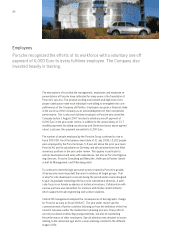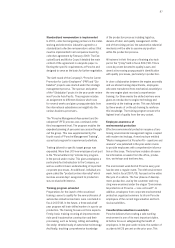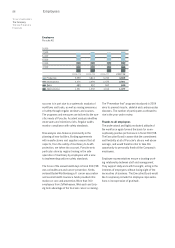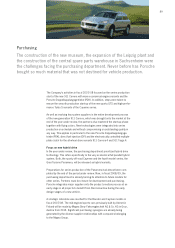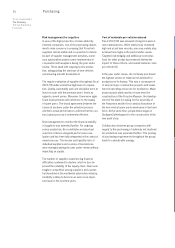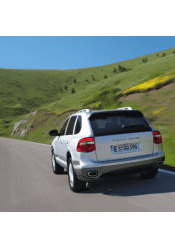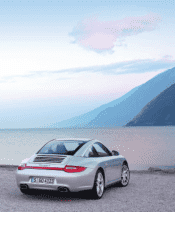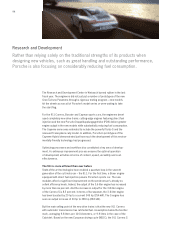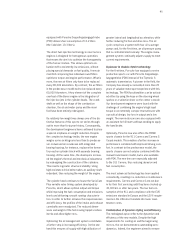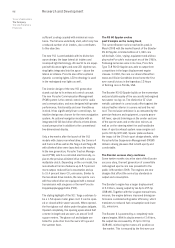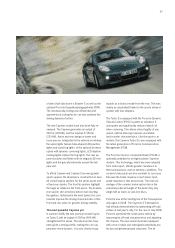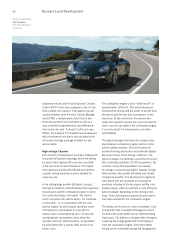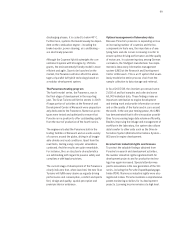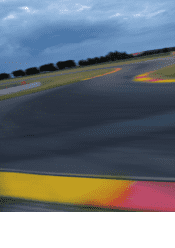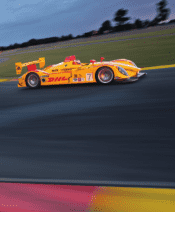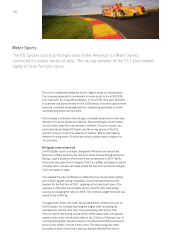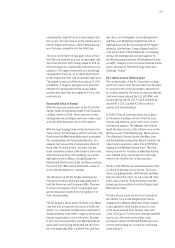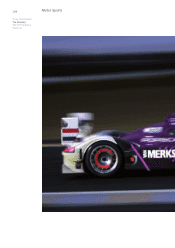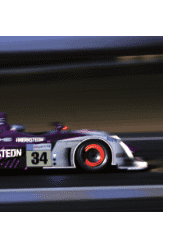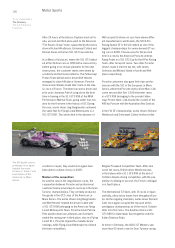Porsche 2007 Annual Report Download - page 99
Download and view the complete annual report
Please find page 99 of the 2007 Porsche annual report below. You can navigate through the pages in the report by either clicking on the pages listed below, or by using the keyword search tool below to find specific information within the annual report.96
sufficient cooling coupled with minimal air resis-
tance. The full area underbody shell, which only has
a reduced number of air intakes, also contributes
to this objective.
The new 911 is unmistakable with its distinctive
apron design, the large lateral air intakes and
revamped light technology. All new 911s are equip-
ped with bi-xenon lights and new LED daytime run-
ning lights integrated into the apron – above the
lateral air intakes. Porsche also offers optional
dynamic cornering lights. LED technology is used
in the redesigned rear lights as well.
The interior design of the new 911 generation
stands out due to its enhanced control concept.
The new Porsche Communication Management
(PCM) system is the central control unit for audio
and communication, and was designed with greater
performance, functionality and user friendliness
in mind. It has significantly fewer control keys. An
intuitive design was chosen for the menu navigation
system. An optional navigation module with an
integrated 40 GB hard drive affords a three-dimen-
sional perspective in addition to the conventional
two-dimensional display.
Only a few weeks after the launch of the 911
models with classic rear-wheel drive, the Carrera 4
and Carrera 4S as well as the Targa 4 and Targa 4S
with all-wheel drive were launched on the market.
In the new generation, Porsche Traction Manage-
ment (PTM), which is controlled electronically, re-
places the previous all-wheel drive with a viscous
multiplate clutch. Depending on the car model, the
new all-wheel Carrera features up to 8.5 percent
more output, reduced fuel consumption and up
to 15.4 percent lower CO2emissions. Similar to
the two-wheel drive models, the new sports cars
with four-wheel drive are equipped with a manual
transmission with six gears or the new Porsche
Doppelkupplungsgetriebe (PDK).
The styling highlight of the 911 Targa continues to
be a 1.54 square meter glass roof. It can be open-
ed or closed within seven seconds. When opened,
the front glass roof slides under the glass tailgate.
Opened completely, the opening spans about half
a meter in length and uncovers an area of 0.45
square meters. The glass roof and tailgate are
tinted for protection from the sun’s UV rays and
the summer heat.
The RS 60 Spyder evokes
past triumphs on the racing track
The current Boxster series reached its peak in
March 2008 with the market launch of the Boxster
RS 60 Spyder. A limited edition of 1,960 cars
will be built. Color, styling, equipment and philoso-
phy evoke Porsche’s motorsport era of the 1960s.
Following numerous wins in its class, Porsche’s
Type 718 RS 60 Spyder was able to outperform
competitors in the large displacement engine
classes. In 1960, the race car drivers Hans Herr-
mann and Olivier Gendebien drove home the first
ever overall victory in the legendary 12 Hours
of Sebring race in Florida, USA.
The Boxster RS 60 Spyder builds on the momentum
and purist philosophy of the successful mid-engined
two-seater racing car. The distinctive GT silver
metallic paintwork is consciously offset against the
natural leather interior in carrera red and the red
roof. The exclusive ambiance is accentuated by the
premium features and equipment, a sporty gears-
hift lever, special trimmings on the center sections
of the sports seats and on the door mirrors as
well as on the steering wheel rim and handbrake
lever. A sports exhaust system raises engine out-
put to 303 hp (223 kW). Spacer plates enhance
the impact of the 19-inch sport design wheels, while
Porsche Active Suspension Management (PASM)
delivers driving pleasure that is both sporty and
comfortable.
The Boxster success story continues
Some twelve months since the start of the Boxster
success story, the next generation of convertible
mid-engined sports cars was presented to the
public in November 2008. The engines are new
designs that afford the series top standards in
output and consumption.
The Boxster’s engine has a larger displacement
of 2.9 liters, raising output by ten hp to 255 hp
(188 kW). Together with the six-gear manual trans-
mission, the engine delivers improved driving per-
formance combined with greater efficiency, which
translates to reduced fuel consumption and lower
CO2emissions.
The Boxster S is powered by a completely rede-
signed engine. With its displacement of 3.4 liters,
the output has increased by 15 hp to 310 hp
(228 kW), reinforcing the motorcar’s position on
the market. This is ensured by the first-ever use
To our shareholders
The Company
The new Panamera
Financials
Research and Development


